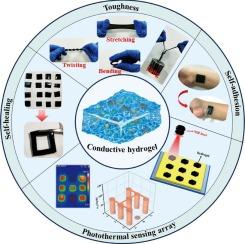基于rGO集成P(AA-HEMA)和淀粉的高性能水凝胶传感器,用于运动和温度监测
IF 12.5
1区 化学
Q1 CHEMISTRY, APPLIED
引用次数: 0
摘要
智能水凝胶材料具有优异的导电性,在柔性电子器件、人机交互系统、软机器人等领域具有广阔的应用前景。然而,开发集传感和驱动能力于一体的多功能水凝胶系统仍面临重大的技术挑战。本研究利用聚多巴胺(PDA)在碱性条件下对氧化石墨烯(GO)进行原位还原,得到了电导率优异、光热转换效率高的还原氧化石墨烯(rGO)。随后,将所得纳米材料与天然多糖淀粉结合制备聚丙烯酸-2-甲基丙烯酸羟乙酯/淀粉/还原氧化石墨烯(P(AA-HEMA)/St/rGO)水凝胶复合材料。该水凝胶体系不仅表现出优异的力学性能(176 kPa的拉伸应力和1258%的应变)和耐久性,而且还表现出高电导率(3.64 S/m)和敏感的传感特性(在1300%的应变下达到5.15的测量系数)。开发的水凝胶传感器可以准确地检测到握拳、脉冲振动和发声等各种生理信号。此外,利用其优异的光热响应特性,建立了三维阵列传感器配置,实现了对环境温度变化的实时监测。本研究通过巧妙的材料设计和结构优化,成功开发出多功能智能水凝胶,为生物医学应用和柔性电子器件提供了一种新颖的材料解决方案。本文章由计算机程序翻译,如有差异,请以英文原文为准。

High performance hydrogel sensor based on rGO integrated P(AA-HEMA) and starch for motion and temperature monitoring
Smart hydrogel materials demonstrated promising application prospects in flexible electronic devices, human-machine interaction systems, and soft robotics owing to their exceptional electrical conductivity. However, significant technical challenges remained to be addressed for developing multifunctional hydrogel systems integrating both sensing and actuation capabilities. In this study, polydopamine (PDA) was employed to conduct in-situ reduction of graphene oxide (GO) under alkaline conditions, yielding reduced graphene oxide (rGO) with superior electrical conductivity and high photothermal conversion efficiency. The resulting nanomaterial was subsequently combined with natural polysaccharide starch to fabricate a poly (acrylic acid-2-hydroxyethyl methacrylate)/starch/reduced graphene oxide (P(AA-HEMA)/St/rGO) hydrogel composite. This hydrogel system exhibited not only exceptional mechanical properties (176 kPa tensile stress and 1258 % strain) and durability, but also demonstrated high conductivity (3.64 S/m) and sensitive sensing characteristics (achieving a gauge factor of 5.15 at 1300 % strain). The developed hydrogel sensor accurately detected various physiological signals including fist clenching, pulse vibration, and vocalization. Furthermore, by leveraging its excellent photothermal response properties, a three-dimensional array sensor configuration was established, enabling real-time monitoring of ambient temperature variations. Through ingenious material design and structural optimization, this research successfully developed a multifunctional smart hydrogel, providing a novel material solution for biomedical applications and flexible electronic devices.
求助全文
通过发布文献求助,成功后即可免费获取论文全文。
去求助
来源期刊

Carbohydrate Polymers
化学-高分子科学
CiteScore
22.40
自引率
8.00%
发文量
1286
审稿时长
47 days
期刊介绍:
Carbohydrate Polymers stands as a prominent journal in the glycoscience field, dedicated to exploring and harnessing the potential of polysaccharides with applications spanning bioenergy, bioplastics, biomaterials, biorefining, chemistry, drug delivery, food, health, nanotechnology, packaging, paper, pharmaceuticals, medicine, oil recovery, textiles, tissue engineering, wood, and various aspects of glycoscience.
The journal emphasizes the central role of well-characterized carbohydrate polymers, highlighting their significance as the primary focus rather than a peripheral topic. Each paper must prominently feature at least one named carbohydrate polymer, evident in both citation and title, with a commitment to innovative research that advances scientific knowledge.
 求助内容:
求助内容: 应助结果提醒方式:
应助结果提醒方式:


